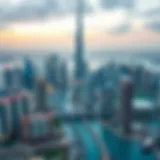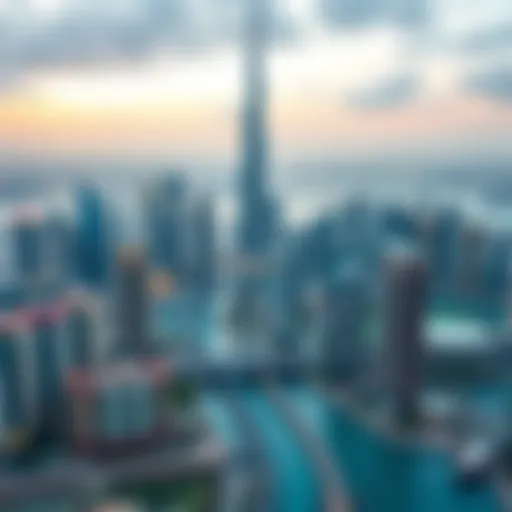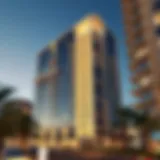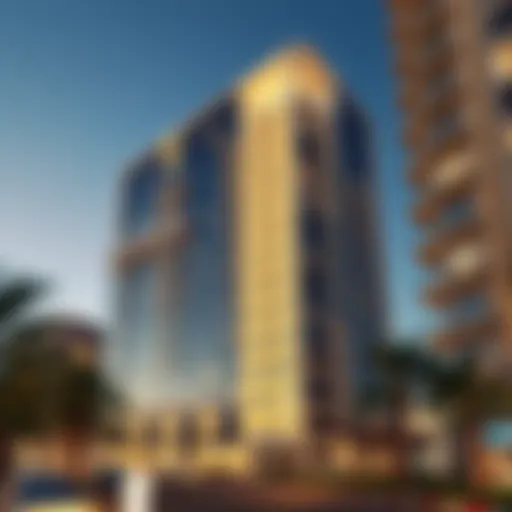Dubai Metro Lines: Impact on Urban Mobility and Real Estate


Intro
Dubai's urban landscape is a vibrant tapestry of culture, commerce, and innovation. The introduction of the metro lines has been a catalyst for this transformation, significantly altering the way residents and tourists navigate this bustling metropolis. At its core, the metro system plays a pivotal role in enhancing urban mobility, connecting key districts and reducing reliance on vehicles. With the expansion of the transit network, we see intriguing shifts in real estate trends that warrant a closer look.
In this article, we delve into the essential interplay between the metro lines and Dubai's real estate market. We will explore not just the journey of the metro system from its inception to current operations, but also its future expansion plans that promise to reshape accessibility across the city. More importantly, we will investigate how these developments influence property values and urban development patterns across different neighborhoods.
As we navigate through this intricate topic, we aim to provide valuable insights for investors, homebuyers, and industry professionals. Understanding how metro accessibility ties into real estate trends does not just equip stakeholders with knowledge; it prepares them to make informed decisions in a rapidly evolving property landscape.
Equipped with data and analyses, we will explore the market insights, dissect current trends, and examine the myriad of economic factors that play into the valuation of properties. We will also arm first-time buyers and seasoned investors with strategies for navigating this dynamic market. As Dubai continues to grow, the importance of urban mobility provided by the metro cannot be overstated.
Intro to Dubai's Metro System
The metro system in Dubai represents a significant milestone in the city’s infrastructure development. It isn’t just a means of transportation; it’s a game changer in how people navigate urban spaces. With the rapid growth of the city, the metro has become instrumental in addressing the transportation challenges that come with urbanization. The development of this system aims to reduce road congestion, lower carbon emissions, and enhance the overall quality of life for residents and visitors alike. In essence, the metro links various districts, making urban mobility smoother and more efficient.
Historical Context of the Metro Development
The roots of Dubai's metro can be traced back to the early 2000s, a period marked by ambitious visions for the city’s future. Various reports and studies highlighted the critical need for a public transport system. In 2005, after much planning and investment, the Dubai Metro project officially commenced. The idea was not only to provide a safe alternative to road travel but also to foster economic growth by connecting key commercial and residential areas. Historical context is vital; it shows how far Dubai has come in a relatively short time. The opening of the Red Line in 2010 was not just a transport solution; it symbolized an era of modernization and development for the emirate.
Objectives and Goals of the Metro Project
The metro project in Dubai was designed with several key goals in mind aimed at improving urban mobility:
- Enhancing Connectivity: One of the primary objectives was to connect different parts of the city, facilitating easy access to employment centers, educational institutions, and leisure spots.
- Reducing Traffic Congestion: With a growing population, traffic congestion was a significant concern. The metro serves as a viable alternative to vehicles, aiming to alleviate some of this burden.
- Promoting Sustainable Transport: The project aims to be eco-friendly. By reducing the reliance on cars, it promotes a cleaner and greener environment.
- Stimulating Economic Growth: The development of metro lines is expected to encourage investment in real estate and commercial establishments along its route, thus promoting economic activity.
Through these objectives, the metro system shapes not just the transportation landscape, but also the economic fabric of Dubai, influencing trends across various sectors.
In summary, the introduction of the metro system was a progressive step towards building a well-rounded urban environment. It has garnered the attention of investors, developers, and the workforce—each playing a role in the urban narrative of Dubai.
Current Operational Lines
The operational lines of the Dubai Metro play a critical role in shaping urban mobility and boosting the real estate sector. Given the rapid development in Dubai, the metro system provides not just transportation but also becomes a driving force for residential and commercial investments. As we look further into the operational corridors, we can understand the depth of their impact on the local economy and community life.
Red Line Overview
The Red Line, stretching approximately 52 kilometers, stands as the backbone of Dubai's Metro system. This line connects the Rashidiya station in the east to the bustling Umm Suqeim area in the west. With 29 stations serving major urban districts such as Downtown Dubai, Dubai Marina, and the Trade Centre, it facilitates a strong interaction with key business hubs.
Its significance extends beyond mere convenience; it transforms commuting norms. For instance, residents no longer require a car for daily travel into the city center, cutting down on traffic congestion and pollution. Property developers have taken notice. Proximity to the Red Line typically boosts property values, with apartments and offices within walking distance commanding higher prices. This phenomenon has been reflected in recent sales reports showing a noticeable uptick in real estate transactions around the Red Line stations.
Green Line Overview
The Green Line runs parallel to the Red Line but serves a unique set of neighborhoods and districts. Covering about 23 kilometers and boasting 20 stations, it connects areas like Deira, Al Qusais, and Al Jaddaf, presenting a vital link for residential communities and commercial centers that may be less accessible via car. The Green Line encourages local development by making these once-isolated areas more attractive to investors.
Residential developments around Green Line stations, such as Al Rigga and Union, are increasingly being designed with easy access as a primary feature. As people seek homes that bring them closer to transit corridors, these neighborhoods have seen a revitalization. Developers have capitalized on this trend by integrating public spaces, malls, and recreational facilities into their projects, further boosting the appeal of living there.
Future Expansion Plans for the Metro
Dubai's vision for its metro stretches well beyond the current operational lines. Plans for expansion target areas such as Hatta and Dubai South, reflecting the ongoing commitment to improve urban mobility. These proposed routes are set to serve more communities and integrate with other transportation frameworks, ensuring an interconnected transit experience.
Moreover, the emirate's economic ambitions drive these developments. As Dubai aims to increase tourist traffic in preparation for upcoming events like Expo 2025, further investments into the metro infrastructure become not only practical but necessary. Additional lines are anticipated to enhance accessibility to entertainment venues and event spaces.
In short, as the metro network expands, so will the adjacent property markets. The synergy between the transportation infrastructure and real estate is poised to grow, making it an essential consideration for anyone looking to invest in Dubai's dynamic market.
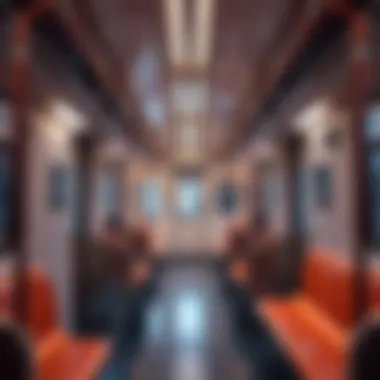

"The infrastructure of the metro directly influences property prices and urban development in ways that go beyond simple transit efficiency."
This relationship between the metro lines and real estate is a core narrative in understanding how mobility affects the growth of urban spaces in Dubai.
Metro Accessibility and Real Estate Dynamics
Understanding the interaction between metro accessibility and real estate dynamics is crucial in grasping Dubai's urban landscape. In a city where rapid development meets innovative transport solutions, the accessibility offered by the metro lines significantly influences property values and the overall market landscape.
When a metro station is introduced in a neighborhood, it tends to breathe new life into the area. Increased accessibility fosters greater foot traffic, which not only benefits local businesses but also attracts new residents and investors. The convenience of quick, reliable transit can markedly elevate the appeal of a location, transforming it from a sleepy suburb to a bustling hub. Therefore, proximity to a metro station often correlates with an increase in demand for residential and commercial properties.
Key considerations regarding metro's reach include:
- Change in Demographics: Areas near metro stations often experience a shift in demographics as more young professionals and families seek accessible living arrangements.
- Investment Attraction: Investors are keen on properties near metro lines. The potential for appreciation becomes apparent as metro connectivity enhances the location's desirability.
- Infrastructure Development: Improved transport facilities typically spur infrastructural developments, indirectly influencing property prices when new amenities sprout up.
The relationship is not just beneficial but also cyclical. Increased property values can lead to even greater quality of life improvements, attracting more business and residential opportunities.
Correlation Between Metro Access and Property Values
The correlation between metro access and property values is not merely anecdotal; various studies have demonstrated that properties located within close proximity to metro stations generally command higher market prices. When a new metro line opens or expands, the surrounding neighborhoods often see property values skyrocketing—sometimes by as much as 10-20% in the first year alone.
Consider Dubai’s Red Line. As properties near the line became more desirable, they attracted both buyers and renters seeking convenience. Furthermore, the allure of reduced commuting times cannot be underestimated. For many, being a short train ride away from key business districts and leisure attractions is a decisive factor in property purchasing decisions.
A study carried out by Dubai Land Department indicated that neighborhoods around metro stations reported a steady rise in property values, proving that these transit developments are a game changer for both investors and homeowners alike.
Impact on Residential Developments
Metro accessibility significantly influences the type of residential developments that emerge in its vicinity. Builders and developers often tailor their projects to meet the demands of a changing demographic that prioritizes urban living with easy transport access.
Modular apartments, mixed-use complexes, and high-rises have increasingly popped up near metro stations, appealing to those who favor lifestyles that blend living, working, and leisure seamlessly. The availability of efficient public transportation is a strong selling point, as it aligns with the desires of today’s residents for mobility without the need for dedicated personal transport.
Moreover, the regulatory landscape has shifted to favor developments near metro stations. Authorities in Dubai are now implementing policies that encourage high-density housing in these prime areas to accommodate the growing influx of urban residents looking for convenience. For instance:
- Increased Density: Developers are permitted to build taller structures to maximize available space, which can ultimately lead to more affordable living solutions.
- Community Considerations: Projects now focus on communal spaces that foster environmental sustainability and social connectivity, aligning with the modern urban ethos.
This transformation creates a vibrant community atmosphere, making residential developments near metro stations not just places to live but vibrant environments where life unfolds daily.
Commercial Real Estate Trends Near Metro Stations
The impact of metro accessibility on commercial real estate sectors is just as pronounced. Businesses view proximity to metro lines as a golden ticket to attracting customers. Retail stores, cafes, and office spaces positioned near metro stations typically experience higher foot traffic, leading to increased sales and visibility.
As such, it’s common to see commercial entities sprout like mushrooms in the areas surrounding metro stations. Developments often comprise a blend of retail and office spaces in what is termed mixed-use developments. These projects enjoy high occupancy rates due to the constant flow of commuters, making them a safe bet for investors. Here are some trends observed:
- Rising Rents: With demand on the up, commercial rents near metro lines have surged higher than those in less accessible areas.
- Brand Clarity: Businesses targeting specific client demographics find it easier to establish a footprint near metro stations, leveraging the large volumes of commuters.
- Long-Term Lease Agreements: Landowners who rent out spaces near metro stations often secure long-term tenants, leading to stable, predictable returns on investment.
To sum up, the interplay between metro connectivity and real estate dynamics encapsulates how urban mobility can transform neighborhoods and bolster property markets. Accessibility brings about tangible benefits that both residential and commercial sectors cannot ignore, shaping the future landscape of Dubai.
Neighborhoods Benefiting from Metro Connectivity
In discussing the intricate relationship between metro connectivity and urban development in Dubai, it’s crucial to focus on specific neighborhoods that have reaped the benefits of this transportation revolution. Metro connectivity isn’t just about speeding up commutes; it's about transforming entire communities. The availability of metro access often correlates with improved property values, heightened investment interest, and the overall desirability of certain areas. With the rapid urbanization Dubai has seen, understanding how metro lines impact various neighborhoods can be a game changer for investors and potential homeowners alike.
Al Barsha: A Case Study
Al Barsha stands out as a quintessential example of how metro connectivity initiates a chain reaction of urban transformation. Once a quiet suburban area, Al Barsha has now morphed into a bustling locale due to the establishment of the Dubai Metro’s Mall of the Emirates station. This station serves as a gateway, allowing residents easy access to key attractions across the emirate.


Real estate prices in Al Barsha have witnessed a notable uptick since the metro line was introduced. The availability of metro services attracts not only local buyers but also expatriates looking for ease of mobility. Enhanced transport options reduce reliance on personal vehicles, cutting down traffic woes, which adds an appealing feature for families and professionals alike. The area has also seen an increase in retail businesses catering to the urban lifestyle, making it a hot spot for commercial opportunities.
"Neighborhoods with metro access are not just more accessible; they bloom into economic hubs where rising property values reflect a vibrant community."
Dubai Marina and Its Transit Advantages
Dubai Marina is another shining example of how metro connectivity can revolutionize a neighborhood. Known for its stunning waterfront and luxury lifestyle, the Dubai Marina Metro station has heightened the area's appeal. The architecture is striking, the views are unforgettable, and with the metro line in the mix, getting around is practically a breeze.
Proximity to the metro enhances the living experience, drawing in a crowd that values convenience and cosmopolitan amenities. Property developers have taken notice, resulting in a surge of high-end apartments and mixed-use developments near the station, catering to both long-term residents and short-term visitors. Additionally, the vibrant retail scene around the marina benefits from increased foot traffic generated by the metro, creating a win-win scenario for all involved.
The Impact of Metro on Downtown Dubai
Downtown Dubai, often seen as the beating heart of the city, has experienced a significant uplift due to metro connectivity. The Burj Khalifa and Dubai Mall, two of the most iconic structures globally, are easily accessible via the metro. This ease of access not only attracts tourists but also enhances the area’s profile as a prime residential and commercial hub.
Since the introduction of the metro, property values in Downtown Dubai have surge, driven by increased demand for both residential and commercial real estate. The allure of being steps away from high-end shopping, gourmet dining, and cultural experiences has led to a competitive market, drawing in investors keen to capitalize on the area’s prestige.
For residents, having a metro station so close means they can enjoy the benefits of urban living without the common headaches of traffic congestion, making it a desirable place to call home. This shift enhances the overall character of the neighborhood, which in turn fuels further real estate development, establishing a cycle of growth and prosperity.
In summary, neighborhoods benefiting from metro connectivity illustrate a complex interaction between public transport and urban real estate. The case studies of Al Barsha, Dubai Marina, and Downtown Dubai demonstrate that with thoughtful urban planning and investment in transportation infrastructure, the ripple effects can positively reshape an entire city's landscape, making it an attractive prospect for both investors and residents.
Metro System and Urban Planning
The synergy between urban planning and the metro system in Dubai is a game changer, not only in terms of efficiently moving people, but as a catalyst for redefining the urban landscape. As the city evolves, the metro network provides a lifeline that binds communities, commercial hubs, and residential areas together, making it a vital element in Dubai’s growth narrative.
Efficient urban planning, in tandem with a robust metro system, can lead to multiple benefits:
- Reduced Congestion: With the increasing number of vehicles on the roads, having a reliable metro network alleviates traffic congestion, encouraging more residents to use public transport.
- Enhanced Connectivity: The metro connects various neighborhoods, allowing for a seamless transition between residential and commercial zones, thus bolstering economic activity.
- Urban Development: Areas close to metro stations typically witness an uptick in development activities, paving the way for new businesses and housing projects, altering the real estate dynamics of these neighborhoods.
- Land Use Optimization: Integrating the metro into city planning encourages high-density developments around stations. This aligns with sustainable growth considerations, making efficient use of available land.
Given these points, it's clear that the role of the metro in urban planning goes beyond being just a mode of transportation; it actively shapes the cityscape itself.
Integration with Other Transportation Modes
The effectiveness of Dubai's metro system is amplified by its thoughtful integration with various other transportation modes. Buses, taxis, and ride-sharing services work in conjunction with metro lines, creating a multi-modal transportation network that offers flexibility and convenience for users.
- Bus Connectivity: Numerous bus stops are strategically located near metro stations, facilitating smooth transfers between different forms of transport. This interconnected route planning aids in reaching destinations that are not directly accessible by the metro.
- Taxis and Ride-Hailing Services: With many commuters opting for door-to-door services, taxi stands alongside metro stations lessen the strain on the public transport system while providing additional convenience.
- Cycling and Walking Paths: The city is increasingly investing in cycling lanes and pedestrian-friendly walkways leading to metro stations. This encourages healthier transportation options and reduces carbon emission levels.
This synergy ensures that commuters experience a comprehensive transport ecosystem, which enhances the attractiveness of Dubai's metropolitan framework.
Sustainability and Environmental Considerations
The metro system plays a pivotal role in promoting sustainability within urban environments. As cities grapple with rising pollution and environmental concerns, creating a sustainable transport infrastructure becomes paramount.
- Reduced Carbon Footprint: The metro drastically cuts down on per capita greenhouse gas emissions compared to individual car usage. This translates into a cleaner, more breathable environment, which is vital for the health of residents.
- Energy Efficiency: The technology used in Dubai's metro system is designed for energy efficiency, such as regenerative braking systems that save energy during operation. Innovations like these demonstrate a long-term commitment to environmental considerations.
- Public Awareness: With the rise of environmental consciousness among residents, the metro also serves as a beacon of sustainable urban transport, encouraging citizens to opt for public transport over private vehicles.
"A well-planned metro system can offer cities a feasible path towards a greener future, as seen in Dubai's evolving urban landscape."
To wrap it up, the synergy between the metro system and urban planning exemplifies how public transport can foster sustainable development while benefitting real estate dynamics. Commitments to ecological sustainability and integrated transport modes are not just essential for the present but are crucial for ensuring future generations enjoy a thriving and sustainable Dubai.
Challenges and Limitations
The construction and development of a robust metro system like Dubai's comes with its share of challenges and limitations. Understanding these factors is crucial for stakeholders such as investors, developers, and urban planners. Addressing such intricacies helps ensure the metro's effectiveness in improving urban mobility and realizes its potential to positively affect real estate. The following two sections explore specific operational challenges faced by metro authorities as well as public perception and usage patterns.
Operational Challenges Faced by Metro Authorities
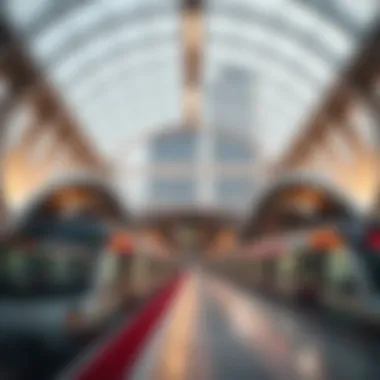

Operating a metro system in a bustling metropolis like Dubai is no walk in the park. Various factors come into play that can impede optimal performance. One major challenge is the maintenance of infrastructure. Given the extreme temperatures in Dubai, the rail tracks and trains need regular upkeep to prevent overheating. If faulty tracks cause delays, passengers can quickly lose patience, affecting overall public perception.
Moreover, the financial implications are significant. Maintaining, upgrading, and expanding service areas require substantial investment, not to mention the costs associated with emergency repairs or unforeseen issues. Operational budgets can become strained, resulting in cutbacks or delays in new projects that were anticipated.
The integration with other transport systems can also pose a challenge. Ensuring seamless transfers between modes can enhance the user experience, but it requires substantial coordination among different transportation stakeholders. If buses, taxis, and ride-sharing services don’t sync well with metro schedules, users may not regard the whole system as viable, reducing its overall utility.
"Public trust in mass transit systems can crumble quickly due to operational hiccups, making it imperative for metro authorities to be proactive in their management strategies."
Public Perception and Usage Patterns
Public perception plays a pivotal role in the success of metro systems. If commuters believe that the metro service is unreliable or inconvenient, they may be less inclined to use it, opting instead for personal vehicles or taxis. Factors such as safety concerns can also cloud public sentiment. In a vibrant city like Dubai, ensuring safety on the metro and at stations is crucial. Incidents, however rare, can deter potential riders.
Moreover, demographic shifts influence usage patterns. Younger generations often lean towards more sustainable transport options, while older populations may be less familiar with navigating a metro system. This necessitates targeted communication strategies to draw in various demographic groups.
Additionally, the convenience factor is paramount. If stations are not within a reasonable distance from residential or commercial areas, the perceived value of the metro diminishes. Users might weight convenience against costs and time lost, resulting in fluctuating patronage levels across the city.
A positive perception can lead to increased metro utilization, which in turn can elevate property values and stimulate residential and commercial developments around metro stations.
In summary, addressing operational hurdles and enhancing public perception can significantly strengthen the metro's role in urban mobility and real estate dynamics in Dubai.
Future Prospects for Dubai's Metro System
As Dubai continues to rise as a global hub for business and tourism, its metro system holds vast potential. The expansion and enhancement of this network are fundamental not only for transportation but also for the future of urban planning and real estate. The stakes are high for investors, developers, and residents alike, as the metro's reach further influences property values and accessibility across the emirate.
Plans for New Lines and Extensions
Recently, the Roads and Transport Authority (RTA) has laid out ambitious plans for new lines and extensions. This development is essential for addressing the increasing demand for public transport in a city that is rapidly urbanizing. Key highlights of these plans include:
- Expansion of Red Line: There are proposals to expand the Red Line to better serve the growing population in emerging neighborhoods. New stations could be added, enhancing connectivity to key urban areas.
- Green Line Upgrades: The possibilities of more efficient train schedules and additional stops along the Green Line have been discussed. This not only increases commuter convenience but also has the potential to elevate adjacent property values.
- Connecting to the Airport: Plans for extending the metro lines to connect with Dubai's main airport can significantly facilitate transit for both locals and travelers, further demonstrating the metro's role in integrating different modes of travel.
Such expansions aren't merely about increasing the rail network; they bring along the benefits of decreased traffic congestion, reduced carbon emissions, and enhanced urban infrastructure. An expanded metro will likely draw new residential and commercial developments, creating opportunities for investors looking to capitalize on emerging areas.
Innovations in Metro Technology and Operations
The future of the metro system will also be shaped by innovations in technology and operations. As cities worldwide embrace advancements, Dubai is no exception. Key areas to consider include:
- Smart Ticketing Systems: Integrating mobile technology for seamless fare payment can streamline user experience. With smart apps, passengers can easily manage travel schedules without hassle.
- Energy Efficiency: Upgrading to more energy-efficient trains is not only cost-effective in the long term but also aligns with Dubai's sustainability goals.
- Real-Time Data Utilization: Sophisticated analytics can help in monitoring passenger flow and optimizing routes. Investing in technology that analyzes usage patterns will enable the RTA to adapt services based on demand, ensuring resources are allocated efficiently.
Investing in innovation not only improves the travel experience but can significantly increase property appeal in metro-adjacent areas.
Ending: Metro Lines as Catalysts for Growth
As we wrap up this analysis, it’s important to recognize that the metro lines in Dubai do more than just facilitate transportation; they serve as powerful drivers of urban and economic growth. They intertwine with the city’s developments, shaping neighborhoods and influencing real estate dynamics in profound ways. The strategic placement of metro stations not only enhances connectivity but also enhances the attractiveness of surrounding areas for both residential and commercial investments.
Final Thoughts on Metro's Role in Urban Development
Dubai’s metro system stands as a vital link in a larger urban strategy. It’s not merely a travel option; it is a catalyst that sparks transformation across various sectors. By enabling easy access to key locations—be it business districts or leisure hubs—the metro draws both people and investments towards its vicinity. Real estate professionals observe that properties near metro stations often see a rise in demand, which naturally inflates their value. More precisely:
- Increased Foot Traffic: Proximal locations to metro stations experience heightened pedestrian activity, a boon for local businesses.
- Development Attraction: Developers are keen to invest in areas serviced by metro links due to anticipated growth in population density and demand.
- Price Apprecitation: The correlation between metro access and real estate value is palpable; homes and commercial spaces near stations typically command higher prices.
Despite these advantages, stakeholders must also contend with challenges from maintenance, public perception, and overall service efficiency that the metro might face over time.
"In cities where public transport flourishes, the economy thrives alongside it, creating a symbiotic relationship that fosters growth and sustainability."
Future considerations regarding the expansion of the metro lines promise even richer prospects. Newly planned routes may open previously unconnected neighborhoods, creating fresh opportunities for investment. Investors and developers armed with insights into these forthcoming changes stand to benefit immensely.
In summary, the metro lines are not just tracks laid across the city; they are vital arteries which nourish urban growth. For investors and real estate professionals, understanding this dynamic can inform smart decision-making, paving the way for sustained success in an ever-evolving market.
As Dubai continues its ascent as a global city, the role of the metro system will only become more significant, so keeping an eye on its developments offers a glimpse into the future of urban development in this vibrant metropolis.
